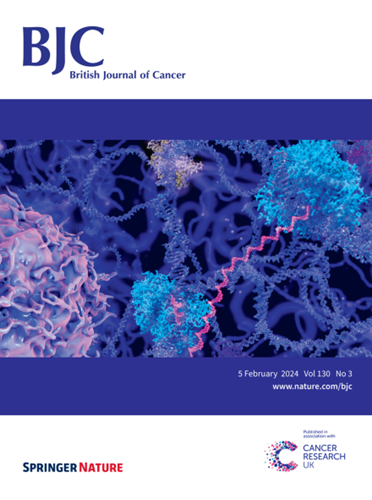小剂量三氧化二砷通过 LOXL3 的表达抑制胰腺星状细胞的活化,从而增强胰腺癌的免疫疗法。
IF 6.4
1区 医学
Q1 ONCOLOGY
引用次数: 0
摘要
背景:胰腺癌(PC)的特点是间质异常纤维化,这明显影响了免疫疗法的效果。小剂量三氧化二砷(ATO,1.0 μM)可抑制胰腺星状细胞(PSCs)的活化并影响纤维化,这是提高免疫疗法敏感性的一种潜在策略:方法:采用细胞外基质(ECM)模型评估 ATO 对 ECM 和外周血单核细胞的调节作用。利用异位 C57BL/6J 模型评估 ATO 对 PC 中 CD8+T 细胞浸润和免疫疗法的影响。此外,为了增强ATO的靶向效应,研究人员还制作了载有ATO的纳米材料(scAbFAP-α-HMSNs-PAA-ATO),专门用于靶向PSCs:结果:低剂量ATO(1.0 μM)抑制了PSCs的活化,显示出协同免疫疗法的潜力。在低剂量 ATO 的干预下,ECM 发生重塑,导致 CD8+T 细胞浸润增加,从而增强了抗 PD-L1 治疗的效果。我们进一步证实,低剂量 ATO 通过调节 PSCs 中 LOXL3 的表达重塑了 ECM。scAbFAP-α-HMSNs-PAA-ATO 的靶向能力得到了提高,抑制纤维化和免疫治疗增敏的能力也得到了增强:我们的研究揭示了低剂量 ATO 可通过调节 LOXL3 重塑 ECM 并增强 CD8+T 细胞浸润,从而提高免疫疗法的疗效,这为 PC 的综合治疗提供了一种新策略。本文章由计算机程序翻译,如有差异,请以英文原文为准。

Low-dose arsenic trioxide inhibits pancreatic stellate cell activation via LOXL3 expression to enhance immunotherapy in pancreatic cancer
Pancreatic cancer (PC) is characterized by abnormally fibrotic mesenchyme, which notably influences on the effectiveness of immunotherapy. Low-dose arsenic trioxide (ATO, 1.0 μM) can inhibit the activation of pancreatic stellate cells (PSCs) and affect fibrosis, which is a potential strategy for enhancing the sensitivity to immunotherapy. Extracellular matrix (ECM) models were employed to assess the regulatory effects of ATO on ECM and peripheral blood mononuclear cells. Orthotopic C57BL/6J models were utilized to evaluate the influence of ATO on CD8+T cell infiltration and immunotherapy in PC. Additionally, nanomaterials loaded with ATO designed to specifically target PSCs (scAbFAP-α-HMSNs-PAA-ATO) were produced to enhance targeting effects of ATO. Low-dose ATO (1.0 μM) suppressed PSCs activation, exhibiting potential for synergistic immunotherapy. Under low-dose ATO intervention, ECM underwent remodeling, leading to increases in CD8+T cell infiltration, thereby enhancing anti-PD-L1 therapy effect. We further demonstrated that low-dose ATO remodeled ECM by regulating the expression of LOXL3 in PSCs. scAbFAP-α-HMSNs-PAA-ATO exhibited improved targeting capabilities, and enhanced capacity to inhibit fibrosis and sensitize immunotherapy. Our research reveals that low-dose ATO, by regulating LOXL3, remodels the ECM and enhances CD8+T cell infiltration, thus sensitizing the efficacy of immunotherapy, which provides a novel strategy for comprehensive treatment to PC.
求助全文
通过发布文献求助,成功后即可免费获取论文全文。
去求助
来源期刊

British Journal of Cancer
医学-肿瘤学
CiteScore
15.10
自引率
1.10%
发文量
383
审稿时长
6 months
期刊介绍:
The British Journal of Cancer is one of the most-cited general cancer journals, publishing significant advances in translational and clinical cancer research.It also publishes high-quality reviews and thought-provoking comment on all aspects of cancer prevention,diagnosis and treatment.
 求助内容:
求助内容: 应助结果提醒方式:
应助结果提醒方式:


